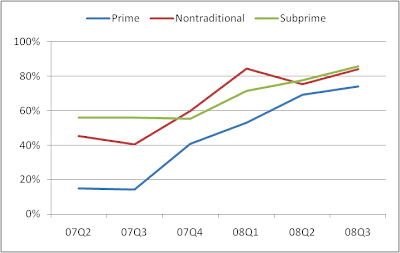A Blast From the Past… How the Housing Crisis Will End (Revisited)
This piece is simply an updated version to a piece I published back on March 5th 2008 titled ‘How will it end’. Despite the fact we are much deeper into this financial crisis; the root of the problem has not changed, and that is the US housing market.
Here it is with updated data and some small changes!
We are continuously being barraged with mixed news concerning the housing crisis. One day we hear signs are pointing towards a bottom; the next housing numbers came in much lower than expectations. So we raise this question: What indicators should we be looking at to truly signal a recovery in housing?
With this question in mind our analysis focused on creating the stages we believe would be necessary to facilitate a recovery. We were able to define 7 chronological stages which need to occur in order for the crisis to end. Additionally, the progress for each of the stages can be measured by several key indicators. The stages we outline below are meant to help to average investor better understand how a recovery will most likely unfold, and includes indicator that anyone with a basic internet connection will be able to easily access.
Our stages and key indicators to watch:
 Source: FRB
Source: FRB
30Y fixed mortgage rates have fluctuated but remain elevated especially when considering the recent rate cuts … Source: Bloomberg
Source: Bloomberg
 Source: Census
Source: Census
The recent crisis has begun to negatively effect the housing affordability index Source: Bloomberg
Source: Bloomberg
Conclusion:
Essentially, this crisis is occurring due to a substantial increase in the supply of houses through subprime foreclosures, and a decrease in demand to buy houses through harder to get mortgages. As more homes enter the market and less people are able to acquire mortgages to by them the price drops. Hence, the first major step in a recovery for the sector will be a slow-down in the number of foreclosures, which has likely been pushed back until second half 2009. Secondly, and equally important banks need to reduce lending standards to allow qualified buyers to purchase new homes. These two actions combined will begin to reduce the inventory of homes on the market and stabilize price. Once the amount of inventory of homes for sale begins to drop, we will see demand for new constructions begin to rise. This will first show up in the building permits index, followed by housing starts, and finally private construction spending. All in all, this will not be a fast process, with the reduction in foreclosures and lowering of lending standards being the hardest hurdle to overcome.
Currently, the primary driver for subprime foreclosures are interest rate resets. When these borrowers we first given their mortgages they were given low teaser rates which would eventually reset into higher adjustable rates. Meaning some mortgage holders who were paying USD1,200 a month for their mortgage in November could be paying USD3,200 a month in December. For a lot of these borrowers it has been nearly impossible to pay the new amount and they have been forced to default. On a positive note, based on available market information we should see the number of resets for adjustable rate subprime mortgages peak sometime in late spring/early summer. However, it is tough to estimate the lag time between mortgage resets and actual foreclosures, which prolong this situation. The deteriorating employment situation in the US will add additional downward pressure to this indicator. All in all there is no quick easy fix on the housing front, and we will likely have to deal with these conditions for quite some time.
Investment Idea:
Once a the market starts showing signs of a sustained recovery we feel that US home builders could significantly benefit. US homebuilder stocks have been pounded since the housing crisis first began, and will be poised to make a recovery as demand for new homes eventually rises. However, as we said this could take some time, but it will happen. I currently hold a long position in ITB, a US home builder ETF.






Join the discussion